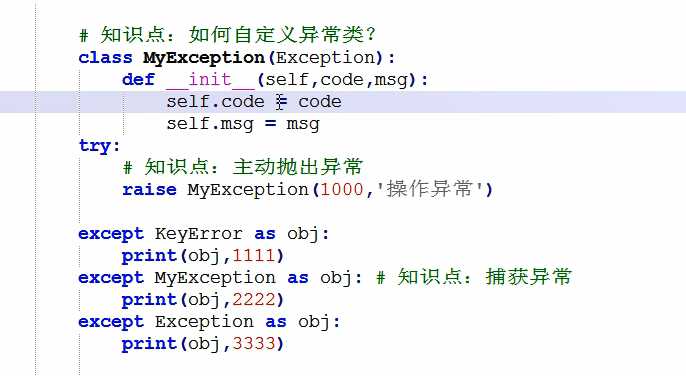面向对象 约束自定义异常加密
Posted wqzn
tags:
篇首语:本文由小常识网(cha138.com)小编为大家整理,主要介绍了面向对象 约束自定义异常加密相关的知识,希望对你有一定的参考价值。
1.约束 开头定义一个约束函数,声明后边函数所使用的方法,主动抛异常raise NotImplementedError("方法(), ") 抽象类和抽象方法的约束 接口中不允许写代码,只能约束,继承他的类,必须实现接口中定义的所有方法 Java中:interface Foo: def f1(self,x1):pass#表示类中必须继承f1方法。可以实现多个接口。 ###抽象类,约束继承他的派生类必须实现它其中的抽象方法 abstact class Foo: def f1(self): print(1,3,4) abstact def f2(self):pass#抽象方法 class Bar(Foo): def f2(self): print(123) ###Bar继承了Foo,就必须继承他的抽象方法,但是抽象类中的正常方法f1可以不用继承 python中的抽象类和抽象方法: 总结: 1.什么是接口以及作用? 是一种数据类型,主要用与约束派生类中必须实现的指定方法,python中没有,Java和c#存在 2.python中使用什么来约束? 抽象类+抽象方法 编写上比较麻烦。 人为的主动抛出异常 3.约束时,抛出的异常可以使用其他方法 专业的写法:raise NotImplementedError(".send() 必须被重写.") 4.应用场景:多个类,内部必须有某些方法是是,需要使用基类加异常进行约束。 自定义异常: 以前的方法: try: a=a1 except Exception as e: print(e) 函数方法: 加密: 引入hashlib模块(帮助加密) obj=hashilb.md5(b"fhfshsjhjksd")#加盐 obj.update("admin".enode("utf-8)) v=obj.hexdigest() print(v) 为防止撞库,使用加盐 日志: 引入模块logging class BaseMessage(object):
def send(self,x1):
"""
必须继承BaseMessage,然后其中必须编写send方法。用于完成具体业务逻辑。
"""
raise NotImplementedError(".send() 必须被重写.")
class Email(BaseMessage):
def send(self,x1):
"""
必须继承BaseMessage,然后其中必须编写send方法。用于完成具体业务逻辑。
"""
pass
obj = Email()
obj.send(1)from abc import ABCMeta,abstractmethod
class Base(metaclass=ABCMeta):#抽象类
def f1(self):
print(123)
@absabstractmethod#抽象方法
def f2(self):
pass
class Foo(Base):
def f2(self):
print(666)
obj = Foo()
obj.f1()
obj.f2()
在文件中找关键字prev
import os
def func(path,prev)
response={"colde":1000,"data:None}
try:
if not os.path.exists(path):
response["code"]=1001
response["data"]="文件不存在"
return response
if onto prev:
response["code"]=1002
response["data"]="关键字为空"
return response
except Exception as e :
response["code"]=1003
response["data"]="未知错误"
return response 面向对象
import os
class ExistsError(Exception):
pass
class KeyInvalidError(Exception):
pass
def new_func(path,prev):
"""
去path路径的文件中,找到前缀为prev的一行数据,获取数据并返回给调用者。
1000,成功
1001,文件不存在
1002,关键字为空
1003,未知错误
...
:return:
"""
response = {‘code‘:1000,‘data‘:None}
try:
if not os.path.exists(path):
raise ExistsError()
if not prev:
raise KeyInvalidError()
pass
except ExistsError as e:
response[‘code‘] = 1001
response[‘data‘] = ‘文件不存在‘
except KeyInvalidError as e:
response[‘code‘] = 1002
response[‘data‘] = ‘关键字为空‘
except Exception as e:
response[‘code‘] = 1003
response[‘data‘] = ‘未知错误‘
return response

import logging
logger =logging.basicConfig(filename=‘日志.txt‘,
format=‘%(asctime)s - %(name)s - %(levelname)s -%(module)s: %(message)s‘,
datefmt=‘%Y-%m-%d %H:%M:%S‘,
level=30)
logging.debug("x1")#10
logging.info("2")#20
logging.warning("x3")#30
logging.error("x4")#40
logging.critical("x5")#50
# # logging.log(10,"x6")
import traceback******************************
def func():
try:
a=a+1
except Exception as e :#获取到堆栈信息
msg=traceback.format_exc()
logging.error(msg)
func()